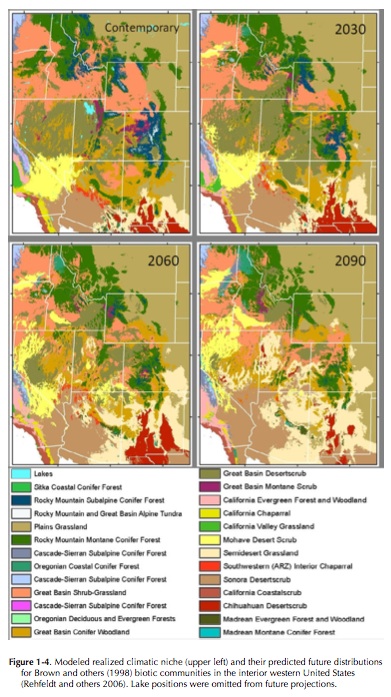“Research has revealed direct evidence of the effects of climate change on ecosystems and many plant and animal speciesâ€
By Summit Voice
SUMMIT COUNTY â€" Some of the most widely accepted climate change models suggest that, by the end of this century, more than half of all western landscapes won’t be able to support the type of vegetation that exist there now.
Specifically, habitat for Rocky Mountain subalpine conifer forests and Great Basin alpine tundra could shrink to nearly nothing; habitat for pinyon-juniper woodlands will move northward and uphill, and semi-desert grassland areas will expand four-fold, according to a new report issued by the Forest Service Rocky Mountain Research Station.
In some areas, flammable invasive species like cheatgrass will expand and increase the risk of wildfires, while other uncommon species like smooth Arizona cypress and the endangered perennial MacFarlane’s four-o’clock may experience complete climate disequilibrium early in the century.
The report focuses on impacts to grasslands as ecosystems that don’t get as much attention as forests, yet are equally at risk to climate change impacts. That lack of attention has left land managers without adequate information to make informed decisions. according to the report.
“Research has revealed direct evidence of the effects of climate change on ecosystems and many plant and animal species. Birds are migrating further north, some plant and animal species are distributed further up mountains than 20-30 years ago, and rivers and marshes in the Southwest are impacted by long-term drought,†said Dr. Deborah Finch, a grasslands, shrublands and desert ecosystems researcher with the Rocky Mountain Research Station.
To fill some of the science gaps, Finch in 2010 encouraged program scientists to evaluate existing knowledge and research needs through the framework of climate change to ignite interest, develop new studies and add a valuable dimension to existing work.
In response, 19 scientists and researchers from the Rocky Mountain Research Station collaborated across six states including New Mexico, South Dakota, Montana, Idaho, Nevada and Utah, and with colleagues from the University of New Mexico, University of Arizona, University of Wisconsin, and Dryland Institute, to summarize the current literature, conduct a needs assessment review, and develop decision support guidelines applicable for land management.
The report addresses animal, plant, and invasive species models and responses, vulnerabilities and genetic adaption, animal species and habitats, and decision support tools for restoration and land management.
It references other research efforts that clearly illustrate climate change impacts, including, for example, a study showing that one species of bumblebee has moved upward about 450 meters (about 1.500 feet) in elevation as temperatures increased by 1.4 degrees Celsius since the 1970s. Host plants may not be able to move upslope at the same rate, creating a disconnect between plants and their pollinators.
The report found that the mismatch between insects and their host plants is increasing for some species. From the report:
“Species most at risk are host specialists, active early in the growing season, poor dispersers, and/or have only one generation per year. Generalist species are likely to become even more widespread. There is a lack of information on interactions as a result of species shifting into new areas.â€
Other findings include:
- Transformations in native and invasive flora and faunaâ€"by the turn of the century, climate in the western U.S. may be incompatible with current vegetation types, resulting in shifting patterns of terrestrial ecosystems.
- In arid and semi-arid shrublands and deserts, invasive grass species with higher flammability, like cheatgrass, will spread and increase both fire frequency and extent.
- Invasive species are one of the greatest threats to the health and sustainability of ecosystems worldwideâ€"invasive species control costs the U.S. an estimated $137 billion annually.
- Climate affects timing, migration, and reproduction cycles of plant and animal speciesâ€"increased temperatures can affect insect development time and result in significant increases in generations per year/per habitat and expose new environments to colonization.
- Increasing water scarcity such as disruption of water flow regimes, and river and wetland drying, are likely to become overriding conservation issues.
- Native intact cold desert shrublands can store 30 percent more carbon than the average regional flora and be restored as an alternative source of carbon sequestration.
39.586656 -106.092081
Filed under: biodiversity, climate and weather, Colorado, endangered species, Environment, global warming Tagged: | climate change, Environment, global warming, Rocky Mountain Research Station

No comments:
Post a Comment